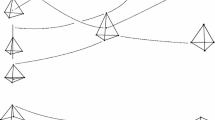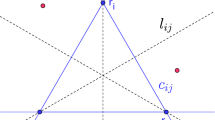Abstract
In this paper we present a complete classification of the isolated central configurations of the five-body problem with equal masses. This is accomplished by using the polyhedral homotopy method to approximate all the isolated solutions of the Albouy-Chenciner equations. The existence of exact solutions, in a neighborhood of the approximated ones, is then verified using the Krawczyk method. Although the Albouy-Chenciner equations for the five-body problem are huge, it is possible to solve them in a reasonable amount of time.
Similar content being viewed by others
References
Albouy A. (1995). Symétrie des configurations centrales de quatre corps. C. R. Acad. Sci. Paris. 320: 217–220
Albouy A. (1996). The symmetric central configurations of four equal masses. Contemp. Math. 198: 131–135
Albouy A. (2003). On a paper of Moeckel on central configurations. Reg. Chaotic Dynamics 8: 133–142
Albouy, A.: Mutual distances in celestial mechanics, preprint (2004)
Albouy A. and Chenciner A. (1998). Le probléme des n corps et les distances mutuells. Invent. Math. 131: 151–184
Albouy A., Fu Y. and Sun S. (2009). Symmetry of planar four-body convex central configurations. Proc. R. Soc. Lond. Ser. A Math. Phys. Eng. Sci. 464: 1355–1365
Bernshteín D.N. (1975). The number of roots of a system of equations. Funct. Anal. Appl. 9(3): 183–185
Bates, D.J., Hauenstein, J.D., Sommese, A.J., Wampler, C.W.: Bertini: Software for Numerical Algebraic Geometry, available at http://www.nd.edu/~sommese/bertini
Brehm, E.: Pertikuläre Integrale des Problems der drei Körper, Dissertation, Berlin (1908)
Chazy J. (1918). Sur certaines trajectoires du probléme des n corps. Bull. Astron. 35: 321–389
Ferrario, D.L.: Central configurations, symmetries and fixed points. e-print, math.DS/0204198 (2002)
Gao T., Li T.Y. and Wu M. (2005). Algorithm 846: MixedVol: a software package for mixed volume computation. ACM Trans. Math. Softw. 31(4): 555–560
Gunji T., Kim S., Kojima M., Takeda A., Fujisawa K. and Mizutani T. (2004). PHoM—a polyhedral homotopy continuation method. Computing 73: 57–77
Hagihara Y. (1970). Celestial Mechanics. 1st edn. MIT press, Massachusetts
Hampton M. (2005). Stacked central configurations: new examples in the five-body problem. Nonlinearity 18: 2299–2304
Hampton M. and Moeckel R. (2006). Finiteness of relative equilibria of the four-body problem. Invent. Math. 163: 289–312
Hampton M. and Santoprete M. (2007). Seven-body central configurations: A family of central configurations in the spatial seven-body problem. Cel. Mech. Dyn. Astr. 99: 293–305
Huber B. and Sturmfels B. (1995). A polyhedral method for solving sparse polynomial systems. Math. Comp. 64: 1541–1555
Kotsireas I. and Lazard D. (2002). Central configurations of the 5-body problem with equal masses in three-dimensional space. J. Math. Sci. 108: 1119–1138
Krawczyk R. (1969). Newton-algorithmen zur Bestimmung von Nullstellen mit Fehlerschranken. Computing 4: 187–201
Leandro E.S.G. (2003). Finitness and bifurcations of some symmetrical classes of central configurations. Arch. Rational Mech. Anal. 167: 147–177
Lee T.L., Li T.Y. and Tsai C.H. (2008). HOM4PS-2.0: a software package for solving polynomial systems by the polyhedral homotopy continuation method. Computing 83: 109–133
Lee, T.L., Li, T.Y.: Mixed volume computation, a revisit (submitted) (2008)
Lehmann-Filhés R. (1891). Ueber zwei Fälle des Vielkörperproblems. Astron. Nachr. 127: 137–143
Li T.Y. (1997). Numerical solution of multivariate polynomial systems by homotopy continuation methods. ACTA Numer. 6: 399–436
Li T.Y. (1999). Solving polynomial systems by polyhedral homotopies. Taiwan J. Math. 3: 251–279
Li T.Y. (2003). Solving polynomial Systems by the Homotopy Continuation Method. Handbook of Numerical Analysis. Amsterdam, North-Holland, 209–304
Li, T.Y., Tsai, C.H.: HOM4PS-2.0para: parallelization of HOM4PS-2.0 for solving polynomial systems (submitted) (2009)
Llibre J. and Mello L.F. (2008). New central configurations for the planar 5-body problem. Cel. Mech. Dyn. Astr. 100: 141–149
Llibre, J., Mello, L.F. and Perez-Chavela, E.: New stacked central configurations for the planar 5-body problem, preprint (2009)
Long Y. and Sun S. (2002). Four-body central configurations with some equal masses. Arch. Rational Mech. Anal 162: 24–44
MacMillan W. and Bartky W. (1932). Permanent central configurations in the problem of four bodies. Trans. Amer. Math. Soc. 34: 838–875
Mizutani T., Takeda A. and Kojima M. (2007). Dynamic enumeration of all mixed cells. Discrete Comput. Geom. 37: 351–367
Moeckel, R.: Some relative equilibria of N equal masses, preprint (1989)
Moore R.E. (1977). A test for existence of solutions for non-linear systems. SIAM J. Numer. Anal. 4: 611–615
Moulton F.R. (1910). The straight line solutions of the problem of n-bodies. Ann. Math. 12: 1–17
MPI (message passing interface): http://www-unix.mcs.anl.gov/mpi/
Perez-Chavela E. and Santoprete M. (2007). Convex four-body central configurations with some equal masses. Arch. Ration. Mech. Anal. 185: 481–494
Pizzetti P. (1904). Casi particolari del problema dei tre corpi. Rendiconti 13: 17–26
Roberts G. (1999). A continuum of relative equilibria in the 5-body problem. Physica D 127: 141–145
Rump S.M. (1999). INTLAB—INTerval LABoratory. In Tibor Csendes, Editor’ Developments in Reliable Computing. Kluwer, Dordrecht, 77–104
Saari D. (1980). On the role and properties of n-body central configurations. Celest. Mech. 21: 9–20
Santos A.A. (2004). Dziobeks configurations in restricted problems and bifurcation. Cel. Mech. Dyn. Astr. 90: 213–238
Smale S. (1970). Topology and mechanics II. Inv. Math 11: 45–64
Smale S. (1998). Mathematical problems for the next century. Math. Intell. 20: 7–15
Tien, F.: Recursion Formulas of Central Configurations, Thesis, University of Minnesota (1993)
Uspensky J.V. (1948). Theory of Equations. McGraw Hill, New York
Verschelde, J.: Algorithm 795: PHCpack: a general-purpose solver for polynomial systems by homotopy continuation. ACM Trans. Math. Softw. 25, 251–276. Software available at http://www.math.uic.edu/~jan (1999)
Sommerville D.M.Y. (1958). An Introduction to the Geometry of n Dimensions. Dover, New York
Williams W.L. (1938). Permanent configurations in the problem of five bodies. Trans. Am. Math. Soc. 44: 563–579
Williams W.L. (1953). A Pentagon theorem. Am. Math. Mon. 60: 616–617
Wintner A. (1941). The Analytical Foundations of Celestial Mechanics Princeton Math Vol. 5. Princeton University Press, Princeton, NJ
Xia Z. (1991). Central configurations with many small Masses. J. Diff. Eqns. 91: 168–179
Xia Z. (2004). Convex central configurations for the n-body problem. J. Diff. Eqns. 200: 185–190
Author information
Authors and Affiliations
Corresponding author
Rights and permissions
About this article
Cite this article
Lee, TL., Santoprete, M. Central configurations of the five-body problem with equal masses. Celest Mech Dyn Astr 104, 369–381 (2009). https://doi.org/10.1007/s10569-009-9219-0
Received:
Revised:
Accepted:
Published:
Issue Date:
DOI: https://doi.org/10.1007/s10569-009-9219-0




